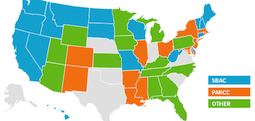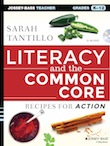PARCC Prep: Literary Analysis Writing Task

This updated post on how to approach the PARCC Literary Analysis Writing Task offers new material developed by Sarah Tantillo. Also see her related post in this series: teaching Compare and Contrast. For more prep ideas, visit her TLC Blog.

As we all strive to help our students meet and exceed the Common Core Standards, one reality we also have to prepare them for is the standardized assessments they will face.
Depending on what state you live in, your students might take the PARCC, the SBAC, or something else. In my home state of New Jersey, we’re gearing up for the PARCC, so I’ve been developing materials to support teachers in that arena. Even if your students are taking a different assessment, I think you’ll find the writing instructional process described here of use.
I have written numerous posts on how to teach literary analysis writing HERE. You will want to review this post on Essential Literacy Work Before You Begin Test Prep. You can also find an array of useful tools, including “Analyzing Literature,” “Literary Response Paper Guide,” and “PARCC Prep,” at The Literacy Cookbook website.
What follows is a sample lesson cycle for teaching the PARCC Literary Analysis Writing Task. It familiarizes students with that genre of writing and builds needed reading and writing skills. You will note that it mirrors the Research Simulation Task in some respects, albeit with literature as opposed to nonfiction (and uses only two texts instead of three).
As with all instruction, I must add the caveat that test prep should not be done 24/7, and while it is necessary, it is not sufficient to prepare students for academic and career success.
Be sure to check out Sarah’s
PARCC ELA Prep Checklist.
It’s a quick diagnostic tool you can use to determine if your students have a clear grasp of some essential strategies that will help them succeed with this genre.
PARCC Literary Analysis:
A 10-Lesson Cycle
Going forward, you will of course want to revisit skills that students need more practice on. For information/resources on the texts and multiple-choice questions typically associated with PARCC Literary Analysis sections, see the TLC “PARCC Prep” page at my site.
Lesson #1
Objective: SWBAT turn a statement into a question in order to unpack PARCC writing prompts.
Time Frame: 50 minutes
Intro:
As we prepare for PARCC, the MOST IMPORTANT thing you need to be able to do is what we are working on today: turning the prompt into a question. 99% of the time, the prompt is not worded as a question and it does not end with a question mark. If you don’t know what the question is, you probably won’t answer it! But if you DO turn it into a question, you should be able to answer it.
Lesson:
As a reminder, when we take the PARCC ELA portion, the FIRST THING YOU SHOULD DO is click forward to the writing prompt so that you can turn it into a question and write it on your scrap paper. Why? Because the question(s) will guide your reading. You will take notes on the texts looking for answers to the question(s).
It’s a simple two-step process. Scan the writing prompt for a VERB indicating what you need to do (such as explain, describe, analyze, evaluate) and a QUESTION WORD such as HOW or WHY.
PS: You can find PARCC-released prompts and items here. You can also find one file with all of the updated Literary Analysis Prompts on the TLC “PARCC Prep” page.
Example Prompt: Think about how the structural elements in “Emergency on the Mountain” differ from the structural elements in the poem “Mountains.” Write an essay that explains the differences in the structural elements between the passage and the poem. Be sure to include specific examples from both texts to support your response.
-> Question: How do the structural elements in “Emergency on the Mountain” differ from the structural elements in the poem “Mountains”? Write an essay explaining the differences.
99% of the time, you will easily find HOW or WHY. If you don’t see HOW or WHY, find the verb and insert HOW:
Example Prompt: Where the Red Fern Grows and “The Lighthouse Lamp” are written from different points of view. Write an essay analyzing the impact of point of view on events in the passage from Where the Red Fern Grows and the impact of point of view on events in the poem, “The Lighthouse Lamp.” Use specific examples from BOTH texts to support your answer.
-> Question: How do the different points of view in Where the Red Fern Grows and “The Lighthouse Lamp” affect the events in each text? Write an essay explaining the impact of the point of view on events in each text.
Look at prompts from various grades (HANDOUT NEEDED). Follow “I Do,” “We Do,” then “You Do.”
Students practice turning given prompts into questions.
NOTE: If prompts require students to infer theme, check out this helpful post on how to infer themes.
Lesson #2
Objective: SWBAT close read text #1 in response to the unpacked prompt in order to take notes for an essay response (untimed).
Time Frame: 40-50 minutes
Intro:
[Do Now: Practice turning prompts into questions.]
Yesterday we practiced turning the prompts into questions. Today we’re going to practice pulling notes out of the texts to ANSWER the question. This is a REALLY IMPORTANT LITERARY ANALYSIS SKILL, not just for the PARCC, but for college and life!
Lesson:
- Review question for this task.
- Create T-chart on blank paper to take notes.
- Model taking notes on ONLY information that relates to the prompt in the first two paragraphs/stanzas (first column).
- Partners read and discuss what should be placed in the notes in next paragraph. Not every paragraph/stanza has relevant information!!!
- Share out ideas; check for understanding that information is most relevant.
- Record those notes on the organizer.
- Continue reading paragraph by paragraph (or stanza by stanza).
Lesson #3
Objective: SWBAT close read text #2 in response to the unpacked prompt, in order to take notes for an essay response (untimed).
Time Frame: 40-50 minutes
Intro:
[Do Now: 1) Practice turning a prompt (PROVIDE THE PROMPT) into a question. 2) When taking the PARCC, why do we ONLY take notes on the question?]
Let’s go over the Do Now. By now, we should all be experts at turning prompts into questions. What about question 2, though? Why is it so important to only take notes on the question? (Discuss)
Today our goal is to get better at taking EFFICIENT notes when reading a text. Because we don’t have all the time in the world!
Lesson:
Practice taking notes again on Text #2. (I Do, We Do, You Do)
Lesson #4
(NOTE: For more thoughts on Compare/Contrast writing, see here.)
Objective: SWBAT:
- Identify similarities among texts in order to address those commonalities when you write your body paragraph.
- Write thesis statement in order to introduce a literary analysis essay.
Time Frame: 30-40 minutes
Intro:
Most of the Literary Analysis prompts ask us to compare and contrast in some way, so we will need to identify similarities in our notes. We’re going to use a simple approach: using checkmarks to identify those similarities. Today we’re also going to practice using a simple fill-in-the-blank sentence for our thesis statement….
Lesson:
Using the T-chart you have been working on, model how and why to put checkmarks next to notes that show similarities between both texts.
Consider providing a pre-completed T-chart on some other topic and have students insert checkmarks for practice.
Show students the thesis statement template:
Thesis statement model:
Both [Text 1] and [Text 2] deal with _________________ [TOPIC/THEME], but they do so in different ways.
Model this with the titles and topic. Give them another prompt to practice with (You should be able to generate this thesis without even reading the texts). PS–You can go back to the original prompts for this.
Lesson #5
Objective: SWBAT use notes in order to write effective body paragraphs.
Time Frame: 50 minutes
Intro:
How do we move from notes to writing? This is one of the hardest things we have to do as readers and writers. Let’s look at how to do this…
Lesson:
The overall structure of the essay will be:
- Paragraph 1: Thesis statement (see Lesson #4)
- Paragraph 2: Body paragraph dealing with Text 1
- Paragraph 3: Body paragraph dealing with Text 2
- Paragraph 4: Body paragraph dealing with similarities
- Paragraph 5: One-sentence punchy conclusion
Today, we’ll work on the first two body paragraphs. Show students a completed model of Body 1 and explain how it works. (NEED HANDOUT) Work on Body 2 together.
Lesson #6
Objective: SWBAT:
- Pull ideas from notes in order to draft body paragraph #3.
- Identify what both texts have in common in order to write a body paragraph explaining these similarities.
- Draft a punchy conclusion sentence in order to complete the essay effectively.
Time Frame: 40-50 minutes
Intro:
Let’s review what we did yesterday… Then we will work together on the “What they all have in common” paragraph.
Lesson:
Body #3 = what they have in common (This needs to be modeled: Instead of drafting this on the spot, show them a completed version, then explain it.)
Last sentence = punchy conclusion sentence that DOES NOT restate the thesis (needs to be modeled; there is not one “right answer”), e.g., “Ultimately, both texts help us realize that __________________.”
Lesson #7
Objective: SWBAT analyze PARCC-released items in order to evaluate them through the lens of the PARCC writing rubric.
Time Frame: 50-60 minutes
Materials: PARCC-released LA item (see http://parcc-assessment.org/released-items), scored student examples, and “User-friendly PARCC Writing Rubric” from TLC “PARCC Prep” page.
Intro:
What does PARCC really expect when we do the Literary Analysis Task? Let’s look at the rubric and some student examples that were scored….
Lesson:
- Analyze the PARCC writing rubric (see TLC “PARCC Prep” page for User-friendly versions), and apply it to several scored student responses (see PARCC-released items).
- I Do, We Do, You Do evaluation of sample student responses using PARCC writing rubric.
Lesson #8
Objective: SWBAT write a timed Literary Analysis response (blank paper and typed writing of tasks) in order to prepare for PARCC.
Time Frame: 60 minutes
Material: Laptops (see note below*), blank paper
Intro: Let’s see how we do!
Lesson:
*Insert the passages into a Google Doc/form so that students can simulate the PARCC test-taking experience.
Lesson #9
(NOTE: Skip a day after Lesson #8 so students who were absent can make up the practice timed test.)
Objective: SWBAT revise their Literary Analysis timed essay response in order to improve their writing.
Time Frame: 40-60 minutes
Material: Laptops
Intro: Today we’re going to see how we did and look at ways to improve. We’ll look at some models and use a revision checklist to strengthen our writing. You will have time to revise your work and meet with me if you have any questions. Our purpose here is not just to get better at PARCC writing but to get better at writing, period.
Lesson:
Phase 1 [First round of revisions, most important stuff]
- Answers the question(s) raised by the prompt.
- Has a clear introduction/thesis statement.
- Paragraphs are focused and logically organized.
- Cites relevant evidence from ALL texts.
- Explains how evidence answers the question(s).
Phase 2 [Second round, also important]
- Proper sentence structure (no run-ons or fragments)
- Effective use of transitions
- Strong vocabulary
- Punchy conclusion that does NOT repeat the thesis
Lesson #10
Objective: SWBAT revise their Literary Analysis timed essay response in order to improve their writing.
Time Frame: 40 minutes
Material: Laptops (optional)
Intro: More time to revise!
Lesson: More time to work on revisions if needed.
Going forward, you will of course want to revisit skills that students need more practice on. For information/resources on the texts and multiple-choice questions typically associated with PARCC Literary Analysis sections, see the TLC “PARCC Prep” page at my site.
___________________________




































thank you